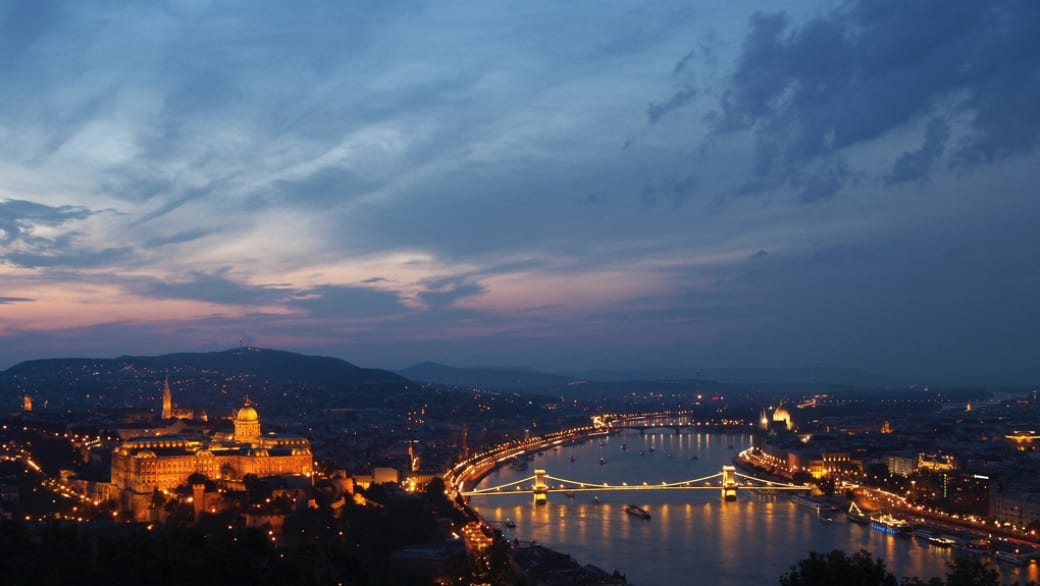Most first-time visitors are surprised to find that Budapest is actually two cites: colorful Buda and hard-working Pest. They are separated by the blue-green waters of the Danube River, which flows placidly past. The monumental architecture and lovely natural setting make this one of Europe’s most eye-catching capitals.
The city is full of United Nations World Heritage Sites, including Buda’s Castle Hill, and the embankments of the Danube River. Andrássy Avenue is a elegant mile and a half thoroughfare of neo-renaissance and neo-baroque villas and mansions between City Park (Városliget) and Downtown. Heroes’ Square (Hsök tere), the Opera House and St Stephen’s Basilica are along the way, and Oktogon Square is at mid-point along the route. Liszt Ferenc Square, just south of Oktogon, is full terrace tables in summer, with good food and drinks at reasonable prices. Also worth a visit are the palatial Hungarian Parliament Building and the impressive Dohány Street Synagogue, the largest in Europe. It is home to only a small Jewish population, as many were killed during World War II.
This “Paris of the East” has long been known as a gay center of Eastern Europe, but things have really taken off since reintegration with the West. There is no single gay neighborhood, but most gay-popular bars and clubs can be found in Pest in the fifth, sixth, seventh, and ninth districts, many within walking distance of one another. Defining lines aren’t drawn as sharply here as in the West — except at men’s saunas or cruise bars — and people mix more. With a little discretion you can look for friendly and meaningful eye-contact most anywhere. Budapest Pride is gay Hungary’s largest annual event, each June. They sponsor other events too, such as a Year End Pride Party in December, and an LGBTQ Film Festival in January.
Although the city is relatively spread out, the system of buses, trams, subways, and light-rail trains gets you around quickly. One ticket is good for any of their modes of transportation. Tickets are available at most stations, and must be validated before you board by using one of the punch machines. Just watch the locals, or ask how. Taxis often overcharge tourists, so it’s best to have your hotel call a reputable company rather than hailing one on the street.
Lodging choices range from among the most opulent hotels in Europe, to simple and inexpensive backpacker hostels, with everything in-between. See our map & listings tab for some suggestions. GayStay/Budapest offers five apartments at four Budapest locations. The helpful staff will gladly take the time to answer guests’ questions about Budapest and gay life around the city. They also do guided tours such as: “Grand Budapest Sightseeing” and “Gay Bars and Clubs.”
The Turkish thermal baths are one of the highlights of a visit to Budapest. Not gay establishments per se, these have been places for men to meet and relax together since the Ottoman era, long before “gay” was a concept, and they still are. The amount of cruising varies widely, so it’s best to ask a local for the latest scoop on the most active. Check our sibling cruising site Squirt.org for more info on places in Budapest to hook-up.
For the most up-to-date travel information on gay Budapest, see our City Guide, Listings Guide, Events Guide and Activities Guide.
Budapest Gayguide has gay accommodations, plus listings for bars, saunas, and saunas. Budapest.com also has gay listings and website links.
Labrisz, the Hungarian Lesbian Association, has local listings, activities and news for the women’s community in Budapest in both Hungarian and English.
Budapest.com is the official Budapest Tourism Bureau website, with general information on area sights, culture, food/drink, shopping and leisure activities.

 Why you can trust Xtra
Why you can trust Xtra